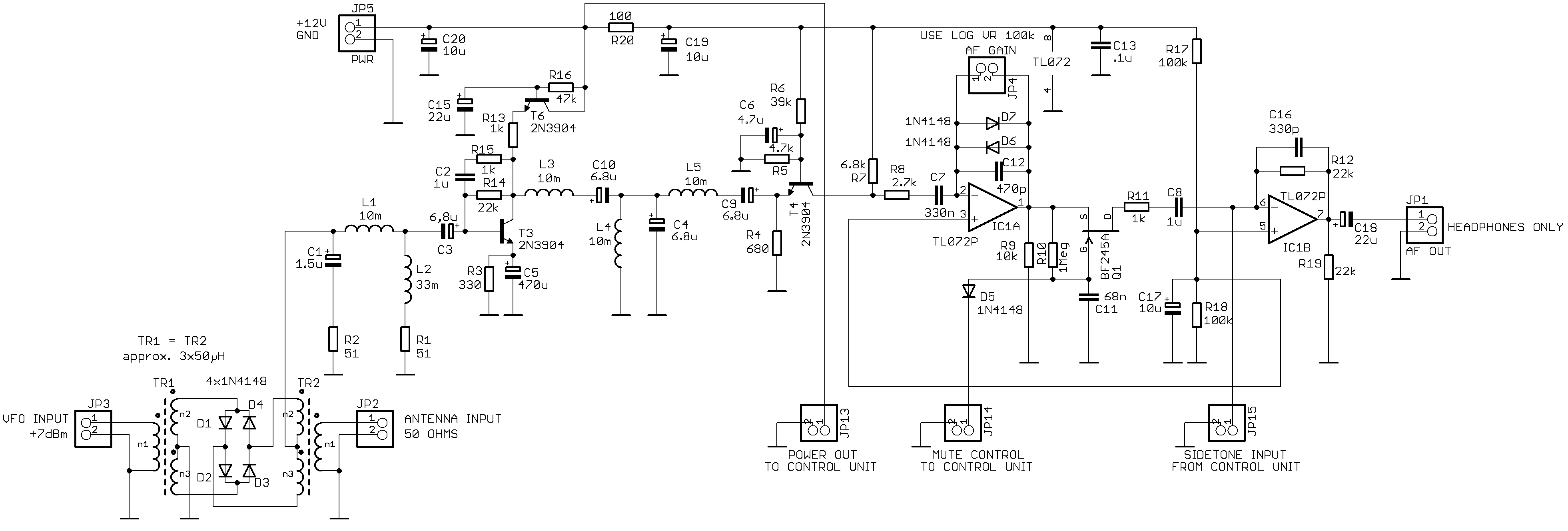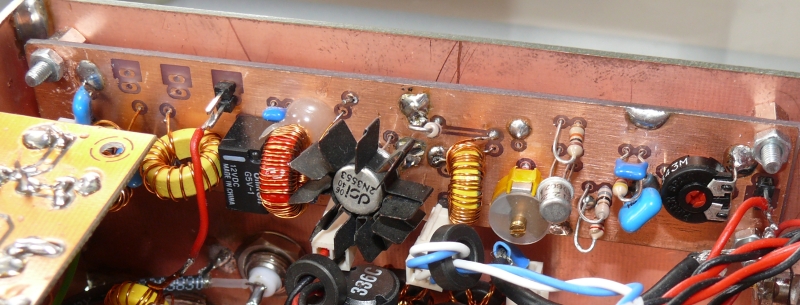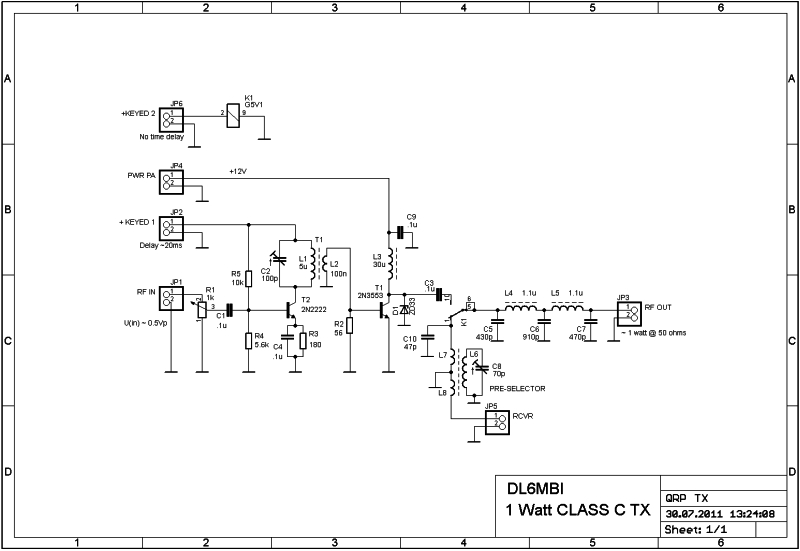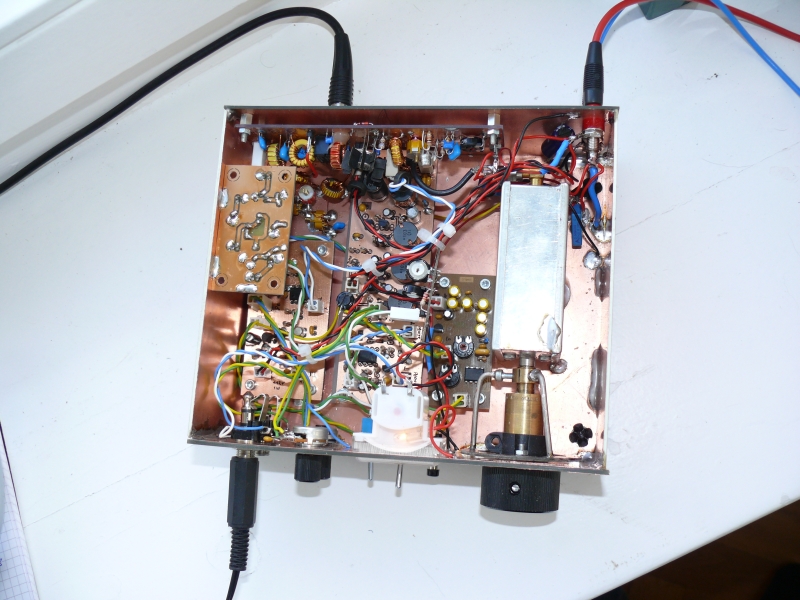CW DC TRX Type 002
Direct Conversion Transceiver for Amateur Radio.
DL6ZB, Rolf Heine
1. Receiver

Picture of the DC receiver showing the diode ring mixer, diplexer, AF filter (0,5-1,5 kHz) and AF amplifier.
This is my Type 002 DC
receiver
of the 002 transceiver project. This receiver uses a L/C Tschebycheff
filter optimized for CW. The muting of this DC receiver design is
full-bk suitable.
Someone would have choosen a 4066 cmos switch mixer, although I
prefer those diode ring mixers because of its simple broadband design.
Just connect
the VFO with a +7 dBm output power to the ring mixer. A receiver like
that one certainly needs a
bandpass input filter or pre-selector. A preamplifier helps isolate the
VFO signal from the antenna, although it is attenuated at least 35
dB
by the diode ring mixer.
The L/C Tschebycheff bandpass filter operates from 0.5-1.5
kHz with a flat insertion loss. It has 50 ohms input/output
impedances. This design allows the use
of readily available 10mH inductors. After various tests I found out
that a -3dB AF bandwidth of 1 kHz is ok for most circumstances on 40m.
Maybe I'll add an active narrow bandwidth filter behind the last AF
stage in the next step of design, although I'm satisfied with the
actual design.
The noise figure of the first AF stage is
about 2.3 dB which is sufficient to detect even weak signals. A 2N4124
would offer some lower noise figure, although in my opinion it isn't
really necessary at
lower HF bands. This receivers "hears" really everything! Nothing
more necessary. The "capacitor-multiplier" T6 helps cleaning the
supply
current for the first AF stage. The capacitor C15 (22µF) is
multiplied by the factor of current amplification of transistor T4.
This easy trick of decoupling the power supply from the first AF stage,
which was used first by W7EL, is very helpful to prevent humming.

10 mH: RS Components No. 675-5333
33
mH: RS Components No. 715-7276
Toroids for diode ring mixer: trifilar 3x50µH wound on Amidon FT37-77, 50µH=8 wdg.
2. QRP Transmitter for 7 MHz

The QRP
transmitter offers approx. 1 watt RF output. Alignment is as simple as
the circuit is. There are two points of adjustment:
a) Adjust C2 for maximum output power.
b) Adjust R1 for about 1 watt output.
What
can you expect from this transmitter? In short: distances to a maximum
of about 500 km during daylight, 1500 km during night when operated at
wire antennas. Signal reports are 539 to 579. Do not expect DX,
although it could be possible with good antennas and at proper condx.

Transceiver performance:
Simply one word: Amazing!
It's hard to believe that such a simple receiver design clearly
detect signals from all over the world while the transmitter catched
applause from most qso partners.
AM breakthrough can be
prevented with a
simple bandpass filter or even a pre-selector (see my pre-selector
page) between the antenna and the receiver RF input. When this receiver
is used without a pre-selector or bandpass-filter AM breakthrough might
be observed. This is because all possible signals reach the antenna
input which is a very extreme condition for all receivers - even the
best!
A
word about humming: the
builder must take care of humming with DC receivers. Proper shielding
of the VFO in a metal housing and good grounding techniques are
essential. Avoid the use of mains power supplies whenever possible. Batteries are definitly the
better choice. I use a sealed 12V lead-acid accumulator with 4.5Ah
capacity which I bought from a local dealer (Pollin Electronic,
www.pollin.de). It is enough for a couple of evenings
operation.
If
low impedance headphones are used humming may be observed due to higher
currents in the unavoidable ground loops. I usually use ancient high
impedance headphones from Sennheiser. After I tested one of these
readily available low impedance headphones against the high impedance
Sennheiser model, I observed very little humming as expected when the
antenna was disonnected. After reconnecting the antenna no humming was
observed because the shortwave noise simply covered the hum.
Even small signals
are always clear with the typical HiFi-sound of those tiny DC
receivers.
Below: pictures of my homebrewed 40m full-bk DC transceiver.
RF output: 1 Watt.
It's a prototype version in a modest housing made of copper-clad
boards. The transceiver will be transferred into a new housing after an
"evaluation period".
Latest improvements:
- Logarithmic S-meter amplifier (SA614)
- VSWR indicator
- Planetary gear for frequency tuning
- Simple mechanical frequency display
Click on picture for better resolution.


The described transceiver was inspired by
W7EL's "Optimized QRP Transceiver' which I had built before, although I made significant changes in the frontend and 50 ohms post-mixer amplifiers / filters.
<<< home






